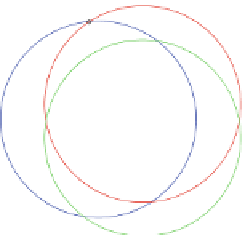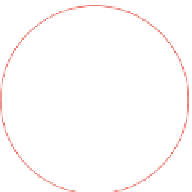Information Technology Reference
In-Depth Information
replacing the bridge point by the intersection point
v
of the first two circles
(see Fig.
22
). It is straightforward to confirm that both
vc
|
.
Thus, the transformation can continue until
v
coincides with either
a
or
c
,at
which point either
a
or
c
becomes a degenerate bridge, and we can continue in
Case II, with one fewer edge.
|
av
|
<
|
ab
|
and
|
<
|
bc
|
Case III: both bridges are degenerate.
As in both previous cases, there are two
sub-cases depending on the span of the middle arc. If the middle arc spans less
than a half circle (refer to Fig.
23
) then we can transform the path by rotating the
second arc, excluding the first bridge point, counterclockwise about the second
bridge point (see Fig.
24
). Of course, if this rotation continues long enough the
second and third circle will coincide, at which point the second bridge disappears.
Prior to this, the transformation preserves the length of all edges except for the
first edge after the first bridge point (
bc
in Fig.
24
) which shortens, since the
distance from both endpoints of this edge to the second bridge point (
y
)is
unchanged but the angle they form with the second bridge point decreases. The
transformation continues until the first vertex on the second arc (
c
) meets the
first circle, at which point it becomes a new degenerate first bridge. We then
continue in Case III, with a smaller second arc.
c
c
b
b
c
a
a
x
x
x
y
y
z
z
Fig. 23.
Fig. 24.
In the second sub-case, the middle arc spans at least a half circle (refer to
Figs.
25
and
27
). Then we can transform the path by rotating the second arc,
this time including both bridge points, counterclockwise about the second bridge
point. As in the previous sub-case, if this rotation continues long enough the
second and third circle will coincide at which point the second bridge disappears.
Prior to this, there are two cases to consider depending on the trajectory of the
first bridge point (
b
).
If the first bridge point (
b
) moves outside the first circle (see Fig.
26
), the
discrete bounded curvature property is maintained at
a
and
b
until
a
joins the
second circle, at which point either
a
or
c
replaces
b
as a degenerate bridge, so
we can continue in Case III.


































Search WWH ::

Custom Search